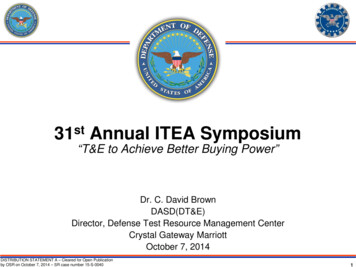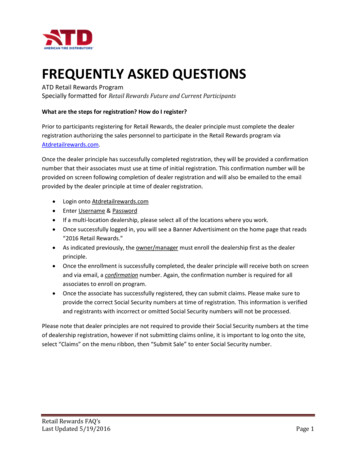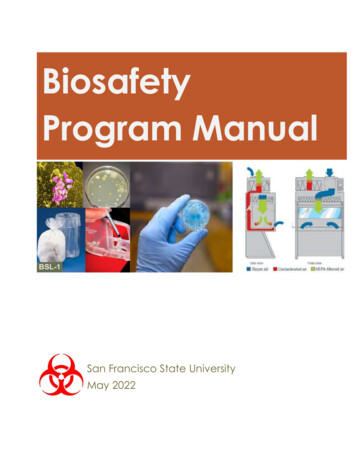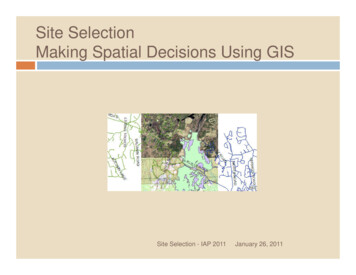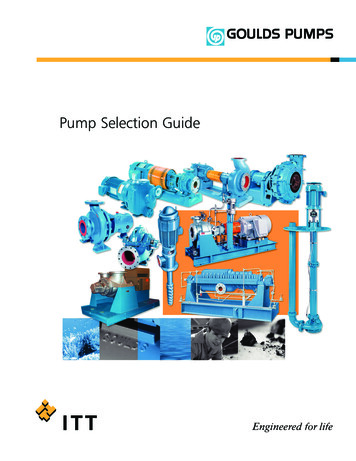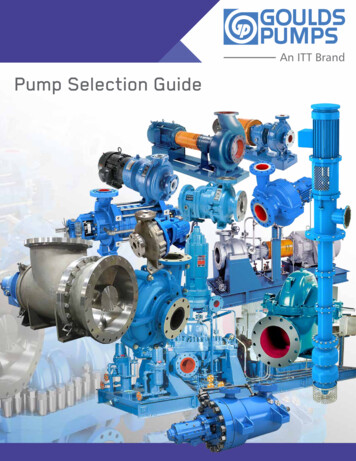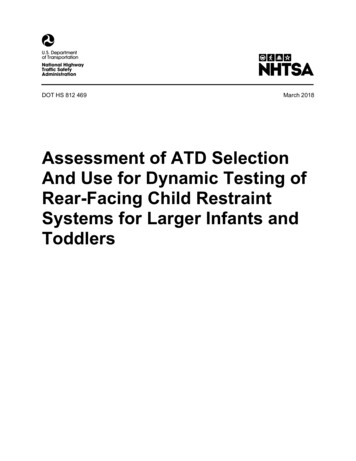
Transcription
DOT HS 812 469March 2018Assessment of ATD SelectionAnd Use for Dynamic Testing ofRear-Facing Child RestraintSystems for Larger Infants andToddlers
This publication is distributed by the U.S. Department of Transportation,National Highway Traffic Safety Administration, in the interest ofinformation exchange. The opinions, findings, and conclusions expressedin this publication are those of the authors and not necessarily those ofthe Department of Transportation or the National Highway Traffic SafetyAdministration. The United States Government assumes no liability for itscontents or use thereof. If trade or manufacturers’ names or products arementioned, it is because they are considered essential to the object of thepublication and should not be construed as an endorsement. The UnitedStates Government does not endorse products or manufacturers.Suggested APA Format Citation:Manary, M. A., Klinich, K. D., & Orton, N. R. (2018, March). Assessment of ATD selection and use for testing of rear-facingchild restraint systems for larger infants and toddlers (Report No. DOT HS 812 469). Washington, DC: NationalHighway Traffic Safety Administration.
Technical Report Documentation Page1. Report No.2. Government Accession No.DOT HS 812 4694. Title and SubtitleAssessment of ATD Selection and Use for Dynamic Testing ofRear-facing Child Restraint Systems for Larger Infants andToddlers3. Recipient's Catalog No.5. Report DateMarch 20186. Performing Organization Code7. Author(s)8. Performing Organization Report No.9. Performing Organization Name and Address10. Work Unit No. (TRAIS)Manary, Miriam A., Klinich, Kathleen D., Orton, Nichole R.University of Michigan Transportation Research Institute2901 Baxter Rd.Ann Arbor MI 4810912. Sponsoring Agency Name and AddressNational Highway Traffic Safety Administration1200 New Jersey Avenue SEWashington, DC 2059015. Supplementary NotesUMTRI-2014-1211. Contract or Grant No.13. Type of Report and Period CoveredApril 2012-Feburary 201414. Sponsoring Agency Code16. AbstractThis report documents a test series that explored methods for using currently available childanthropomorphic test devices (ATDs/crash test dummies) to dynamically evaluate child restraintsystems (CRS) for children more than 1 year old facing rearward in motor vehicles. These CRS aremore typically rear-facing convertible seats but also can be infant-only rear-facing seats. Thestudy evaluated five installation methods using the Hybrid III 3-year-old ATD and the CRABI 18month-old ATD. Three child restraint system models were evaluated using the current FMVSS No.213 test bench. None of the ATD conditions produced a systematic change in the dynamicresponse criteria evaluated by FMVSS No. 213, but some methods were easier to implement in thelaboratory. The report documents each method and their potential advantages and disadvantages.17. Key WordChild restraints, rear-facing, posture, toddlers,lower extremity posture19. Security Classif. (of this report)Form DOT F 1700.7 (8-72)18. Distribution StatementThis document is available to the publicthrough the National Technical InformationService, www.ntis.gov.20. Security Classif. (of this page)Reproduction of completed page authorizedi21. No. ofPages4322. Price
Table of ContentsList of Figures .iiList of Tables . iiiBackground .1Objective .5Methods .5Results .7Discussion .11References .14Appendix A: Exploration of Alternate Rear-Facing Postures and Lower ExtremityModifications for the Hybrid III 3YO . A-1Appendix B: Modifications in TP-213-09 Associated With Each Test Condition . B-1i
List of FiguresFigure 1. Intact Hybrid III 3YO in convertible CRS. . 2Figure 2. Hybrid III 3YO with knee joint stops removed. . 2Figure 3. Hybrid III 3YO with lower legs removed. . 3Figure 4. Hybrid III 3YO with lower legs attached alongside thighs. . 3Figure 5. Hybrid III 3YO with bent knees. . 4Figure 6. Weighted CRABI-18MO. 4Figure 7. Differences in CRS maximum rotation from baseline condition for eachmodel (gray box shows normal range of repeatability). . 9Figure 8. Differences in HIC between baseline and alternative ATD configurations(gray box shows normal range of repeatability). . 10Figure 9. Differences in chest clip between baseline and alternative ATDconfigurations (gray box shows normal range of repeatability). . 10ii
List of TablesTable 1. Test Conditions . 5Table 2. ATD Installation Methods . 6Table 3. FMVSS No. 213 Response Measures . 8Table 4. Comparison of Seated Height and Body Mass for ATDs and U.S. Toddlers. 12Table 5. Advantages and Disadvantages of Each Installation Approach . 13iii
BackgroundFederal Motor Vehicle Safety Standard (FMVSS) No. 213 designates the appropriateanthropomorphic test device (ATD) for dynamic testing based on themanufacturer’s designated occupant mass and height ranges for each child restraintsystem (CRS) usage mode (NHTSA, 2013). For rear-facing CRS testing, the newbornis used to represent the smallest CRS occupants, while the Child Restraint Air BagInteraction (CRABI) 12-month-old (12MO) is used to represent the child forproducts with maximum occupant weights up to 10 kg and heights up to 850 mm inany orientation. In addition to testing with the CRABI-12MO, the Hybrid III 3-year-old (3YO) is also used for products rated for use with children up to 18 kg and 1,100mm standing height.The 2011 American Academy of Pediatrics (AAP) and National Highway TrafficSafety Administration recommendations emphasize keeping children rear-facingbeyond 1 year of age, when possible (AAP, 2011; NHTSA, 2014). In response, manyrear-facing products are now rated to higher occupant mass capacities of 15-, 18-, oreven 20 kg and must be tested using the Hybrid III 3YO. While children typicallybend or cross their legs when seated in rear-facing seats, the 3YO dummy’s legscannot always be positioned this way (Ebert et al., 2014). Figure 1 shows thenominal ATD leg posture in a rear-facing (RF) configuration. Sometimes theinteraction between the leg and seat back makes installation of the CRS on theFMVSS No. 213 test bench challenging.1
Figure 1. Intact Hybrid III 3YO in convertible CRS.The interaction between the legs and the seat back of the FMVSS No. 213 test benchcan affect the installation, particularly the recline angle of the CRS and the lap beltpre-test tension level. An informal survey of child restraint manufacturers andtesting facilities identified the common modifications to the ATD leg position tomake the ATD easier to use in the RF configuration when problems arise. Theyinclude:-Remove the ATD knee joint stops (basically removing two bolts from the kneejoint assembly) to allow the leg to hyperextend at the knee, shown in Figure 2.Figure 2. Hybrid III 3YO with knee joint stops removed.-Remove the lower leg completely as shown in Figure 3. This is used forCanadian compliance when a CRS product is labeled for use with children 16 kgor less.2
Figure 3. Hybrid III 3YO with lower legs removed.-Remove the lower leg and attach the shank mass to the sides or top of thigh asshown in Figure 4. This is used for Canadian compliance when a CRS product islabeled for use with children 16 kg.Figure 4. Hybrid III 3YO with lower legs attached alongside thighs.Other approaches that were not reported in the survey but were considered in theinitial test series were:-Bending the leg at the knee as shown in Figure 5. This is considered to be theclosest to actual child postures in this situation, although this issue will beaddressed in a companion study.3
Figure 5. Hybrid III 3YO with bent knees.-Adding mass to the torso and thigh of the CRABI-18MO to achieve 33 to 35 lb,shown in Figure 6. This approach eliminates the leg-to-vehicle-seat-backinterference and might better approximate the shape of a higher mass 2-year-old child, rather than the midsize sized 3-year-old child represented bythe 3YO ATD.Figure 6. Weighted CRABI-18MO.Appendix A documents related work comparing ATD postures with those of childvolunteers measured in RF and FF CRS (Ebert et al., 2015). It also describes somepossible changes to the Hybrid III 3YO ATD’s lower extremities that were exploredto allow more realistic RF postures, but were not pursued because of minimalimprovement compared to the postures currently possible with the ATD.4
ObjectiveA pilot test series was conducted to assess the current methods for resolving leg-tobench interaction issues when testing rear-facing child restraints with ATDs thatrepresent children over 1 year old.MethodsThe current test series used three convertible CRS: a Graco Comfort Sport (GCS), aCosco Scenera (CS), and a Cosco Scenera 40RF (CS40). These models were selectedbecause they have fairly large market share and relatively upright back supportangles when installed on the FMVSS No. 213 test bench (about 33 to 35 degreesfrom vertical). An upright installation creates a more challenging environment forATD fit.Table 1 lists the test conditions used for testing. With the exception of the “no leg”condition, each CRS was tested once in each ATD configuration (no modification, noknee joint stop, no shank, relocated shank, bent knee and weighted 18MO) todetermine the effect of different installation methods on the FMVSS No. 213specified CRS and ATD responses.Table 1. Test ConditionsDescriptionConditionATDA - baseline3YOATD intactC - no leg3YOLower legs removed (ATD mass reduced 2.2 kg)B - knee stopD - shankE - bentF - CRABI3YO3YO3YOCRABI18MOKnee joint stops removedLower legs taped to upper thighsLegs bentMass added to torso thighs to reach 15 kgThe tests were performed using the FMVSS No. 213 test bench on the impact sled atthe University of Michigan Transportation Research Institute (UMTRI). The CRS5
were secured to the FMVSS No. 213 test bench with a lap belt. A piece of lightweightstring was used to maintain the position of rear-facing restraints during sled launch.The string broke at low tension when loaded during the primary impact.The ATDs were positioned generally following the laboratory test procedure forFMVSS No. 213 (TP-213-09) with the small modifications noted in Table 2 andillustrated in Figures 1 to 6. Appendix B contains excerpts from TP-213-09 andshows the text changes that would be needed if each method was used.ConditionA – baseline(see Fig 1)B – knee stop(see Fig 2)C - no leg(see Fig 3)D – shank(see Fig 4)E – bent(see Fig 5)F – CRABI(see Fig 6)Table 2. ATD Installation MethodsChanges to Dummy PreparationChanges to Dummy Installation(TP-213-09, 12D.4)(TP-213-09, 12D.5.2)No changeNo changeKnee stop bolts removedfrom each kneeLower shank of leg removedfrom each leg.Lower shank of leg removed andtaped/tie-wrapped to upper legNo changeMass of ATD increased to 15 kg bywrapping lead sheeting around torsoand upper leg of ATDNo changeNo changeNo changeLegs bent at knee as far as possiblewithout significant interaction withthe CRS. Then, feet of ATD orientedto achieve full contact between soleof shoe and seat back of FMVSS No.213 test bench.No changeThe test data were digitized in real time and filtered according to the requirementsof SAE J211. Signals in this report conform to the SAE J1733 sign convention.Photographic data were collected with high-speed digital video cameras at 1000frames per second from both side and overhead or forward directions. The videosare marked by a strobe flash at the onset of impact that corresponds to time zero onthe data plots.For the rear-facing test configuration, the primary FMVSS No. 213 dynamic responsevariables are: CRS structural integrity, CRS maximum rotation angle, HIC (36), chest6
acceleration 3ms clip and ATD containment inside the CRS. The structural integritywas assessed by visual inspection of the samples. Initial and maximum CRS backsupport angle was measured from the high-speed video frames. In one of the tests(run NT1243) the CRS moved out of position on sled start-up, invalidating theresults. The conditions of this run were correctly tested in test NT1245.ResultsObservations on feasibility of each approach – Removing the joint stops and bendingthe legs at the knees were methods that were easy to accomplish and added littletime to the test process. Removing the legs and attaching them to the upper legs wasnot as simple and the reattached segments were not sufficiently rigidly coupled witha straightforward taping method. Additionally, the added bulk of the ATD thighshowed potential for interfering with CRS lateral features in an unrealistic way. Inone test (not reported), the tape broke and the leg became detached, whichnecessitated discarding the test and repeating the condition. Adding mass to theCRABI-18MO was not difficult but since the ATD does not have large interiorcavities, it was accomplished by wrapping flexible weights around the torso andthighs, thus changing the ATD exterior shape.Observations on installation – The baseline installation condition and the legs bentinstallation condition created the most bracing of the ATD between the occupantCRS and the seat back of the FMVSS No. 213 test bench. The bracing occurred whenthe ATD posture required the hip or knee joints to be positioned at the joint stopsand thus created a separating force between the back support of the CRS and theseat back of the FMVSS No. 213 test bench that tended to recline the CRS. The onlyreactive force available was contact with the seat and the tension of the lap belt.Achieving the correct installation angle and the correct lap belt tension under thebracing condition increased the difficulty proper test set-up. That bracing, combinedwith the required lap belt tension, also created a very tightly coupled restraintsystem before the test. In contrast, in the configurations where the ATD legs did not7
touch the FMVSS No. 213 test bench, the installation was stable but there was morepotential movement in the installation. Removing the knee joint stops created anintermediate level of bracing. The CRABI-18MO was easier to install than the larger,bulkier 3YO and despite the added exterior weight and the feet did not reach theseat back of the FMVSS No. 213 test bench.Response data - The key FMVSS No. 213 dynamic performance measures for eachtest are summarized in Table 3. On these key variables, all the relevant FMVSS No.213 criteria were met and few large changes in the data were observed. None of theCRS showed any signs of structural failure. In every configuration, the ATD head andtorso were fully contained within the restraint throughout the test, meetingrequirements of FMVSS No. 213, S5.1.3.2.Table 3. FMVSS No. 213 Response 12CRSCONFIGDummyAngleAngle(36)Chest (g)per S5.1.3.253CSA- baseline3YO465734239yes55CSD - shank3YO455629639yes545257CSB – knee stopCSE - bentCS18MO@33lbCS40B – knee stop3YOCS40E - bentCS4048CS405156414245464447CS40A- baselineD - shankB – knee stop3YOGCSD - shankGCSGCSC – no legE - bentF - CRABI4544443YOGCSGCS443YO18MO@33lbA- baseline453YOF - CRABIGCS443YOF - syesyesyesyesyesyesyesyesyesyesyesyesyes
Maximum back support angle – Figure 7 shows the difference between the maximumback support rotation angle for different configurations compared with the baselineconfiguration performance. In this data, a 1- to 2-degree difference is not practicallyof consequence and is within the expected test-to-test variation level. Removing theknee stops and bending the legs had little effect on the maximum CRS rotation. TestsDegrees of Rotationdifference from Baselinewith the CRABI-18MO showed slightly less maximum CRS rotation.3210-1-2-3-4-5-6-7baseline gure 7. Differences in CRS maximum rotation from baselinecondition for each model (gray box shows normal range of repeatability).HIC(36) – Figure 8 shows the differences in HIC observed between the baselineconditions and the configurations tested. In these data, differences of 50 points inHIC are within the range of expected repeatability of the metric. These data show asomewhat lower HIC in all but one of the configurations. The test with the lower legsremoved and reattached along the sides of the thigh produced a higher HIC in theGCS.9
HIC(36) differencefrom Baseline100806040200-20-40-60-80baseline kneestop relocatedbentcrabiCSCS40GCSConfigurationFigure 8. Differences in HIC between baseline and alternativeATD configurations (gray box shows normal range of repeatability).3ms Chest Clip – Figure 9 shows the difference between the resultant chestacceleration 3ms clip for different ATD configurations compared with the baselineconfiguration performance. In these data, a 2- to 3 g difference is within theexpected test-to-test repeatability variation level. The GCS showed a small increasein chest clip with the knee stops removed and a decrease in chest clip with the ATDChest Clip (g) difference fromBaselineshank relocated.6420-2-4-6-8baseline kneestop relocatedbentcrabiCSCS40GCSConfigurationFigure 9. Differences in chest clip between baseline and alternativeATD configurations (gray box shows normal range of repeatability).10
DiscussionThis pilot study tested the various approaches used to adapt the Hybrid III 3YO foruse in FMVSS No. 213 testing. Some had differences in terms of practicalconsideration, but any approach based on the 3YO did not show a systematic effecton dynamic performance measures of the FMVSS No. 213 test. Using the weightedCRABI-18MO tended to reduce the maximum CRS rotation angle and the HICmeasures, although adding mass to the ATD compromises use of the accelerationbased measurements. (Use of a weighted 6YO for higher weight harness testing doesnot consider acceleration measures for this reason.)The initial concern that motivated this effort, focused on some of the conflictsbetween the legs and FMVSS No. 213 test bench when using the 3YO in rear-facingCRS. Since the 2011 NHTSA and AAP recommendations to keep children rear-facingpast 1 year old when feasible, more consumers have been seeking products thataccommodate larger children. As manufacturers try to meet this need withoutmaking CRS that are hard to fit in vehicles, a conflict between the FMVSS No. 213-required head containment requirement and the seated height of the 3YO ATD hasarisen for many rear-facing CRS products, including both rear-facing-only and rear-facing convertibles. Table 4 compares the seated height and mass of the 3YO, CRABI-18MO, weighted CRABI-18MO, and the corresponding U.S. anthropometry data fromthe Centers for Disease Control and Prevention (CDC) and the UMTRIanthropometry of infants and children study (Kuczmarski, 2002; Snyder, 1977).These data suggest that the Hybrid III 3YO is the closest match in seated height andtotal mass to a large 2-year-old.11
Table 4. Comparison of Seated Height and Body Mass for ATDs and U.S. ToddlersSeated HeightTotal MassCRABI-18MOCRABI-18MO - weightedHybrid III 3YO95% 2 YO (UMTRI)99% 2YO MALE ing the informal survey of the child restraint manufacturers, some offeredopinions on their internal approaches and preferences to testing for larger childoccupants in rear-facing CRS. Table 5 summarizes the potential advantages anddisadvantages of each configuration from these conversations and the experiencefrom the pilot testing process.Based on the relatively small variation in dynamic response data among theconfigurations, none of the rear-facing configurations are expected to change theperformance of a child restraint from passing to failing FMVSS No. 213requirements. Nor would any products shift from “barely passing” to passing. Theconfiguration with the lower leg of the 3YO removed is probably the least desirableconfiguration, since it reduced the overall mass of the ATD and is therefore lesssuitable to represent higher mass rear-facing occupants. However, this method isused by Transport Canada. It would be difficult to specify a method of taping thelower legs to the thighs in a manner that is repeatable across labs; we had to discardone test because the leg became detached during our first attempt. In addition, thelower legs can shift even when taped. Again, this method was considered because itis used by Transport Canada. The method of removing the knee stops is the easiestto-implement method that is already in use by test laboratories and CRSmanufacturers.12
Table 5. Advantages and Disadvantages of Each Installation ApproachAdvantagesDisadvantages Easy to accomplish quickly in Does not fully solve conflicts of fittinglaboratory setting.ATD in smaller convertible or RF-onlyCRS due to seated height of ATD. Many child restraint manufacturers Although greatly eased, there can stilland test labs report using thisbe leg-to-bench issues.approach. Minimal change to ATD Has little effect on FMVSS No. 213response data.Removing Completely solves leg-to-bench Reduces ATD mass by 2.2 kg3YO lower legissue Does not fully solve conflicts of fittingand leaving itATD in smaller convertible or RF-only Used by Canada for products ratedofffor children under 16 kgCRS due to seated height of ATD. Has little effect on FMVSS No. 213response data.Removing Completely solves leg-to-bench Shanks need to be tightly fastened to3YO lower legissue.the thigh or there is relativeand attaching Used by Canada for products ratedmovement between the two elementsit to thighduring the test.for children over 16 kg The added bulk of the reattached Has little effect on FMVSS No. 213shank can create fit issues in CRS withresponse data.narrower spaces to the sides of theoccupant upper leg. Does not fully solve conflicts of fittingATD in smaller convertible or RF-onlyCRS due to seated height of ATD.Bending the Easy to accomplish quickly in Creates the maximum amount of3YO legslaboratory setting.bracing between the CRS and bench. No change to ATD May increase leg-to-bench conflicts. Has little effect on FMVSS No. 213 Some CRs have shorter seated arearesponse data.that may not have enough space forthis approach. Closest approximation (that ispossible with this ATD) to how Does not fully solve conflicts of fittinglarger children sit rear-facing basedATD in smaller convertible or RF-onlyon anecdotal observationCRS due to seated height of ATD Likely the closest approximation to To our knowledge, method not usedhow a modified Hybrid III 3YOpreviously by CRS manufacturerswould be positionedAdding mass ATD has shorter seated height and Current FMVSS No. 213 accelerationto the CRABImay better represent toddlers whobased criteria not relevant.18MO toare heavy for their height. Need to develop a weightreach 15 kg.kit/procedure compatible with ATD Completely solves leg-to-benchissue. CRABI 18MO not a part 572 ATDConfigurationRemoving3YO kneestops13
ReferencesAmerican Academy of Pediatrics, Committee on Injury, Violence, and PoisonPrevention. (2011). Policy Statement: Child passenger safety. Pediatrics 127:788793.Ebert, S. M., Klinich, K. D., Manary, M. A., Malik, L. M., & Reed, M. P. (2015). Toddlerlower extremity posture in child restraint systems (Report No. DOT HS 812 470). AnnArbor, MI: University of Michigan Transportation Research Institute.Kuczmarski, R. J., Ogden, C. L., Guo, S. S., Grummer-Strawn, L. M., Flegal, K. M.,Mei, Z.,Johnson, C. L. (2002, May). 2000 CDC growth charts for the United States: Methodsand development. (National Center for Health Statistics, Vital Health Stat Series 1,Number 246). Atlanta: Centers for Disease Control and Prevention. Available atwww.cdc.gov/nchs/data/series/sr 11/sr11 246.pdfCFR 49, Transportation, Part 571.213; Child restraint systems.National Highway Traffic Safety Administration. (2005, November 1). LaboratoryTest Procedure for FMVSS No. 213: Child Restraint Systems. (Test Procedure CodeTP-213-08). Washington DC: Author. Available a.pdfSafe Kids Worldwide. (2014). National Child Passenger Safety Certification Training.(Web-page-based training). Washington, DC” Author.Snyder, R. G., Schneider, L. W., Owings, C. L., Reynolds, H. M., Golomb, D. H., & Schork,M. A. (1977, May 31). Anthropometry of Infants, Children, and Youths to Age 18 forProduct Safety Design. (Final Report. Highway Safety Research Institute Report No.UM-HSRI-77-17). Bethesda, MD: Consumer Product Safety Commission.14
Appendix A: Exploration of Alternate Rear-Facing Postures andLower Extremity Modifications for the Hybrid III 3YOA-1
Initial assessment of different rear-facing lower extremity postures for the Hybrid III3YOThe lower extremities were positioned in five different postures currently beingused by child restraint manufacturers and test labs. Overall, none of the postures ledto different outcomes relevant to the child restraints meeting regulatory standards.The posture suggested in the report for future use is shown in Figure A1. Thisposture removes the knee stop from the lower extremities and places the lowerextremities so they are elevated up on the seatback.Figure A1. Elevated leg posture used with standard 3YO ATD, with knee stopsremoved.Another “bent leg” posture was also evaluated in the initial test series as shown inFigure A2. This posture was anticipated to be one of the more common postureschosen by rear-facing children based on anecdotal experience. A potential issue withthis posture was that it caused the dummy’s feet to put pressure on the buckA-2
seatback. This interaction made it challenging to achieve the correct pretest belttension and child restraint seatback angle.Figure A2. Bent leg posture evaluated in initial test series.Modifying the 3YO ATDAfter reviewing the volunteer data and identifying the most common postures, the3YO ATD was placed in a rear-facing child restraint on the FMVSS No. 213 buck andan attempt was made to replicate these postures with the standard ATD. The“elevated” condition was not evaluated, as we had already tested this posture in theinitial testing.The main issue with the “relaxed” posture was that when the feet were placedagainst the bench seatback and knees bent, there was substantial force against thebench seatback. This could potentially affect the child restraint seatback angleduring test setup, and this posture also made it difficult to achieve and maintain thecorrect belt tension with the child restraint installation. With the current ATD,installation was easier (and led to less force against the seatback) when the ATDlegs were placed in an approximation of the frog leg (with knees drawn back tochest) or feet together (with knees pointing outwards) postures.When considering potential modifications to the 3YO lower extremities to allow amore realistic rear-facing posture, we applied the following criteria: Avoid modifying the pelvis/thorax flesh if possible; Change as few parts as possible; Avoid flesh modifications near the top front of the thigh where the harnessstraps interact with the dummy if possible; and Avoid changes to improve rear-facing posture that affect response inforward-facing testing.A-3
To explore possible changes to the 3YO ATD that might allow it to be positioned inone of these common postures seen in child volunteers more easily, the upper legform was scanned and a model made using a 3-D printer. This strategy was pursuedbecause it is substantially less expensive and quicker than purchasing andmodifying a standard dummy upper leg. Two different strategies were consideredfor increasing the range of motion of the 3YO thigh. One was to try modifying thecontour of the flesh near the joint. Figure A3 shows how the thigh mold was taperedto allow greater range of motio
the 3YO ATD. Figure 6. Weighted CRABI-18MO. Appendix A documents related work comparing ATD postures with those of child volunteers measured in RF and FF CRS (Ebert et al., 2015). It also describes some possible changes to the Hybrid III 3YO ATD's lower extremities that were explored
